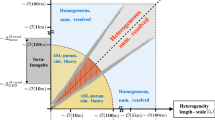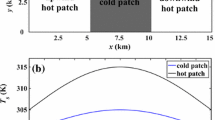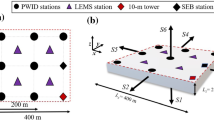Abstract
While the increasing availability of computational power is enabling finer grid resolutions in numerical-weather-prediction models, representing land–atmosphere exchange processes remains challenging. This partially results from the fact that land-surface heterogeneity exists at all spatial scales, and its variability does not necessarily ‘average’ out with decreasing size. The work presented here uses large-eddy simulations and the concept of dispersive fluxes to quantify the effects of a surface that is thermally inhomogeneous (with scales that are approximately 10% of the height of the atmospheric boundary layer), but uniformly rough. These near-canonical cases describe inhomogeneous scalar transport over a broad range of unstable atmospheric flows. Results illustrate the existence of a regime where the mean flow is mostly driven by the surface thermal heterogeneities. In this regime, the contribution of the dispersive fluxes can account for more than 40% of the total sensible heat flux at 100 m above the ground and about 5–10% near the surface. This result is independent of the spatial distribution of the thermal heterogeneities and weakly dependent on the averaging time used to define the dispersive fluxes. Additionally, an alternative regime exists where the effects of the surface thermal heterogeneities are quickly blended and the dispersive fluxes match those obtained over an equivalent homogeneous surface. Results further illustrate the existence of a new cospectral scaling for the dispersive sensible heat fluxes that differs from the traditional turbulence cospectral scaling. We believe that these results might elucidate pathways for developing new parametrizations for the non-canonical atmospheric surface layer.












Similar content being viewed by others
References
Albertson JD, Parlange MB (1999) Natural integration of scalar fluxes from complex terrain. Adv Water Resour 23:239–252
Ament F, Simmer C (2006) Improved representation of land-surface heterogeneity in a non-hydrostatic numerical weather prediction model. Boundary-Layer Meteorol 121(1):153–174
Arola A (1999) Parameterization of turbulent and mesoscale fluxes for heterogeneous surfaces. J Atmos Sci 56(4):584–598
Avissar R (1991) A statistical-dynamical approach to parameterize subgrid-scale land-surface heterogeneity in climate models. Surv Geophys 12(1–3):155–178
Avissar R (1992) Conceptual aspects of a statistical-dynamical approach to represent landscape subgrid-scale heterogeneities in atmospheric models. J Geophys Res 97(D3):2729–2742
Avissar R, Pielke RA (1989) A parameterization of heterogeneous land surfaces for atmospheric numerical models and its impact on regional meteorology. Mon Weather Rev 117(10):2113–2136
Bailey BN, Stoll R (2013) Turbulence in sparse, organized vegetative canopies: A large-eddy simulation study. Boundary-Layer Meteorol 147(3):369–400
Basu S, Lacser A (2017) A cautionary note on the use of Monin-Obukhov similarity theory in very high-resolution large-eddy simulations. Boundary-Layer Meteorol 163(2):351–355
Beare RJ (2014) A length scale defining partially-resolved boundary-layer turbulence simulations. Boundary-Layer Meteorol 151(1):39–55
Beljaars ACM, Holtslag AAM (1991) Flux parameterization over land surfaces for atmospheric models. J Appl Meteorol 30(3):327–341
Bennett LJ, Weckwerth TM, Blyth AM, Geerts B, Miao Q, Richardson YP (2010) Observations of the evolution of the nocturnal and convective boundary layers and the structure of open-celled convection on 14 June 2002. Mon Weather Rev 138(7):2589–2607
Blyth EM (1995) Using a simple SVAT scheme to describe the effect of scale on aggregation. Boundary-Layer Meteorol 72(3):267–285
Blyth EM, Dolman AJ, Wood N (1993) Effective resistance to sensible- and latent- heat flux in heterogeneous terrain. Q J R Meteorol Soc 119(511):423–442
Bou-Zeid E, Meneveau C, Parlange MB (2004) Large-eddy simulation of neutral atmospheric boundary layer flow over heterogeneous surfaces: Blending height and effective surface roughness. Water Resour Res 40(2):1–18
Bou-Zeid E, Meneveau C, Parlange MB (2005) A scale-dependent Lagrangian dynamic model for large eddy simulation of complex turbulent flows. Phys Fluids 17(2):025105
Brutsaert W (1982) Evaporation into the atmosphere. Springer, Dordrecht
Brutsaert W (2005) Hydrology. Cambridge University Press, Cambridge
Calaf M, Meneveau C, Meyers J (2010) Large eddy simulation study of fully developed wind-turbine array boundary layers. Phys Fluids (1994-present) 22(1):015110
Calaf M, Meneveau C, Parlange MB (2011) Large Eddy Simulation study of a fully developed thermal wind-turbine array boundary layer. In: Kuerten H, Geurts B, Armenio V, Fröhlich J (eds) Direct and large-eddy simulation VIII, ERCOFTAC Series, vol 15. Springer, Dordrecht
Charuchittipan D, Babel W, Mauder M, Leps JP, Foken T (2014) Extension of the averaging time in eddy-covariance measurements and its effect on the energy balance closure. Boundary-Layer Meteorol 152(3):303–327
Cheng H, Castro IP (2002) Near wall flow over urban-like roughness. Boundary-Layer Meteorol 104(2):229–259
Claussen M (1990) Area-averaging of surface fluxes in a neutrally stratified, horizontally inhomogeneous atmospheric boundary layer. Atmos Environ Part A Gen Top 24(6):1349–1360
Claussen M (1991) Estimation of areally-averaged surface fluxes. Boundary-Layer Meteorol 54(4):387–410
De Roo F, Mauder M (2018) The influence of idealized surface heterogeneity on virtual turbulent flux measurements. Atmos Chem Phys 18(7):5059–5074
Eder F, Schmidt M, Damian T, Träumner K, Mauder M (2015) Mesoscale eddies affect near-surface turbulent exchange: Evidence from lidar and tower measurements. J Appl Meteorol Clim 54(1):189–206
Finnigan JJ (1985) Turbulent transport in flexible plant canopies. The forest–atmosphere interaction. Springer, Dordrecht, pp 443–480
Finnigan JJ (2000) Turbulence in plant canopies. Ann Rev Fluid Mech 32(1):519–571
Foken T (2006) 50 years of the Monin–Obukhov similarity theory. Boundary-Layer Meteorol 119(3):431–447
Foken T (2008) The energy balance closure problem: an overview. Ecol Appl 18(6):1351–1367
Giometto MG, Christen A, Meneveau C, Fang J, Krafczyk M, Parlange MB (2016) Spatial characteristics of roughness sublayer mean flow and turbulence over a realistic urban surface. Boundary-Layer Meteorol 160(3):425–452
Hultmark M, Calaf M, Parlange MB (2013) A new wall shear stress model for atmospheric boundary layer simulations. J Atmos Sci 70(11):3460–3470
Inagaki A, Letzel MO, Raasch S, Kanda M (2006) Impact of surface heterogeneity on energy imbalance: a study using LES. J Meteorol Soc Jpn 84(1):187–198
Jacob C, Anderson W (2017) Conditionally averaged large-scale motions in the neutral atmospheric boundary layer: Insights for aeolian processes. Boundary-Layer Meteorol 162(1):21–41
Kaimal JC, Finnigan JJ (1994) Atmospheric boundary layer flows: their structure and measurement, 1st edn. Oxford University Press, Oxford
Kanda M, Inagaki A, Letzel MO, Raasch S, Watanabe T (2004) LES study of the energy imbalance problem with eddy covariance fluxes. Boundary-Layer Meteorol 110(3):381–404
von Kármán T (1931) Mechanical similitude and turbulence. Nachrichten von der Gesellschaft der Wissenschaften zu Gottingen - Fachgruppe I (Mathematik) 5:1–19
Konrad TG (1970) The dynamics of the convective process in clear air as seen by radar. J Atmos Sci 27:1138–1147
Kravchenko A, Moin P (1997) On the effect of numerical errors in large eddy simulations of turbulent flows. J Comput Phys 131(2):310–322
Li D, Bou-Zeid E (2013) Synergistic interactions between urban heat islands and heat waves: the impact in cities is larger than the sum of its parts. J Appl Meteorol Clim 52(9):2051–2064
Li D, Katul GG, Bou-Zeid E (2015) Turbulent energy spectra and cospectra of momentum and heat fluxes in the stable atmospheric surface layer. Boundary-Layer Meteorol 157(1):1–21
Lilly D (1967) Representation of small scale turbulence in numerical simulation experiments. In: Proceedings of the IBM scientific computing symposium on environmental sciences (December), pp195–210
Margairaz F, Giometto MG, Parlange MB, Calaf M (2018) Comparison of dealiasing schemes in large-eddy simulation of neutrally stratified atmospheric flows. Geosci Model Dev 11(10):4069–4084
Martilli A, Santiago JL (2007) CFD simulation of airflow over a regular array of cubes. Part II: analysis of spatial average properties. Boundary-Layer Meteorol 122(3):635–654
Mason PJ (1988) The formation of areally-averaged roughness lengths. Q J R Meteorol Soc 114(480):399–420
Mauder M, Desjardins RL, Pattey E, Gao Z, van Haarlem R (2008) Measurement of the sensible eddy heat flux based on spatial averaging of continuous ground-based observations. Boundary-Layer Meteorol 128(1):151–172
Mignot E, Barthelemy E, Hurther D (2009) Double-averaging analysis and local flow characterization of near-bed turbulence in gravel-bed channel flows. J Fluid Mech 618:279–303
Moeng C, Sullivan PP (2015) Large-eddy simulation. In: Encyclopedia of Atmospheric Sciences, Elsevier, pp 232–240
Moltchanov S, Bohbot-Raviv Y, Duman T, Shavit U (2015) Canopy edge flow: a momentum balance analysis. Water Resour Res 51(4):2081–2095
Monin A, Obukhov A (1954) Basic laws of turbulent mixing in the surface layer of the atmosphere. Contrib Geophys Inst Acad Sci USSR 24(151):163–187
Morrison TJ, Calaf M, Fernando HJS, Price TA, Pardyjak ER (2017) A methodology for computing spatially and temporally varying surface sensible heat flux from thermal imagery. Q J R Meteorol Soc 143(707):2616–2624
Munters W, Meneveau C, Meyers J (2016) Shifted periodic boundary conditions for simulations of wall-bounded turbulent flows. Phys Fluids 28(2):025112
Patton EG, Sullivan PP, Moeng CH (2005) The influence of idealized heterogeneity on wet and dry planetary boundary layers coupled to the land surface. J Atmos Sci 62(7):2078–2097
Poggi D, Katul GG (2008) The effect of canopy roughness density on the constitutive components of the dispersive stresses. Exp Fluids 45(1):111–121
Poggi D, Katul GG, Albertson JD (2004) A note on the contribution of dispersive fluxes to momentum transfer within canopies. Boundary-Layer Meteorol 111(3):615–621
Pope SB (2000) Turbulent flows. Cambridge University Press, Cambridge
Prandtl L (1932) Zur Turbulenten Strömung in Rohren und langs Glätten. Ergebnisse der Aerodynamischen Versuchsanstalt zu Göttingen B 4:18–29
Raupach MR (1994) Simplified expressions for vegetation roughness length and zero-plane displacement as functions of canopy height and area index. Boundary-Layer Meteorol 71(1–2):211–216
Raupach MR, Shaw RH (1982) Averaging procedures for flow within vegetation canopies. Boundary-Layer Meteorol 22(1):79–90
Raupach MR, Thom AS (1981) Turbulence in and above plant canopies. Annu Rev Fluid Mech 13(1):97–129
Raupach MR, Coppin PA, Legg BJ (1986) Experiments on scalar dispersion within a model plant canopy part I: The turbulence structure. Boundary-Layer Meteorol 35(1–2):21–52
Salesky ST, Anderson W (2018) Buoyancy effects on large-scale motions in convective atmospheric boundary layers: Implications for modulation of near-wall processes. J Fluid Mech 856:135–168
Salesky ST, Chamecki M, Bou-Zeid E (2017) On the nature of the transition between roll and cellular organization in the convective boundary layer. Boundary-Layer Meteorol 163(1):41–68
Smagorinsky J (1963) General circulation experiments with primirive equations. Mon Weather Rev 91(3):99–164
Stoll R, Porté-Agel F (2006) Dynamic subgrid-scale models for momentum and scalar fluxes in large-eddy simulations of neutrally stratified atmospheric boundary layers over heterogeneous terrain. Water Resour Res 42(1):1–18
Stoll R, Porté-Agel F (2009) Surface heterogeneity effects on regional-scale fluxes in stable boundary layers: surface temperature transitions. J Atmos Sci 66(2):412–431
Stoy PC, Mauder M, Foken T, Marcolla B, Boegh E, Ibrom A, Arain MA, Arneth A, Aurela M, Bernhofer C, Cescatti A, Dellwik E, Duce P, Gianelle D, van Gorsel E, Kiely G, Knohl A, Margolis H, McCaughey H, Merbold L, Montagnani L, Papale D, Reichstein M, Saunders M, Serrano-Ortiz P, Sottocornola M, Spano D, Vaccari F, Varlagin A (2013) A data-driven analysis of energy balance closure across FLUXNET research sites: the role of landscape scale heterogeneity. Agric For Meteorol 171–172:137–152
Stull RB (1988) An Introduction to boundary layer meteorology. Springer, Dordrecht
Taylor PA (1987) Comments and further analysis on effective roughness lengths for use in numerical three-dimensional models. Boundary-Layer Meteorol 39(4):403–418
Weckwerth TM, Horst TW, Wilson JW (1999) An observational study of the evolution of horizontal convective rolls. Mon Weather Rev 127(9):2160–2179
Wieringa J (1986) Roughness-dependent geographical interpolation of surface wind speed averages. Q J R Meteorol Soc 112(473):867–889
Wilson NR, Shaw RH (1977) A higher order closure model for canopy flow. J Appl Meteorol 16(11):1197–1205
Wood N, Mason PJ (1991) The influence of static stability on the effective roughness lengths for momentum and heat transfer. Q J R Meteorol Soc 117(501):1025–1056
Wyngaard JC (2004) Toward numerical modeling in the “terra-incognita”. J Atmos Sci 61(14):1816–1826
Wyngaard JC (2010) Turbulence in the atmosphere. Cambridge University Press, Cambridge
Xie ZT, Coceal O, Castro IP (2008) Large-eddy simulation of flows over random urban-like obstacles. Boundary-Layer Meteorol 129(1):1–23
Zhou Y, Li D, Liu H, Li X (2018) Diurnal variations of the flux imbalance over homogeneous and heterogeneous landscapes. Boundary-Layer Meteorol 168(3):417–442
Acknowledgements
The authors would like to thank Prof. Katul (Duke University) for fruitful discussions and Prof. Anderson (UT Dallas) for the suggestion to consider using the spectrogram representation. This project has been developed with the support of the U.S. National Science Foundation Grant Number PDM-1649067. Marc Calaf also acknowledges the Mechanical Engineering Department at the University of Utah for start-up funds, and the Center for High Computing Performance (CHPC) at the University of Utah for computing hours. This work used the Extreme Science and Engineering Discovery Environment (XSEDE), which is supported by National Science Foundation Grant Number ACI-1548562. The authors declare no conflict of interest.
Author information
Authors and Affiliations
Corresponding author
Additional information
Publisher's Note
Springer Nature remains neutral with regard to jurisdictional claims in published maps and institutional affiliations.
Rights and permissions
About this article
Cite this article
Margairaz, F., Pardyjak, E.R. & Calaf, M. Surface Thermal Heterogeneities and the Atmospheric Boundary Layer: The Relevance of Dispersive Fluxes. Boundary-Layer Meteorol 175, 369–395 (2020). https://doi.org/10.1007/s10546-020-00509-w
Received:
Accepted:
Published:
Issue Date:
DOI: https://doi.org/10.1007/s10546-020-00509-w




